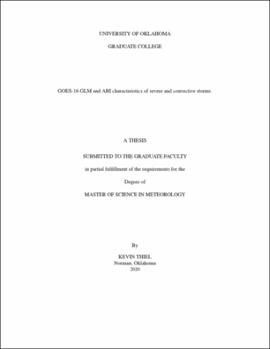| dc.contributor.advisor | MacGorman, Donald | |
| dc.contributor.author | Thiel, Kevin | |
| dc.date.accessioned | 2020-07-30T17:17:04Z | |
| dc.date.available | 2020-07-30T17:17:04Z | |
| dc.date.issued | 2020-07 | |
| dc.identifier.uri | https://hdl.handle.net/11244/325328 | |
| dc.description.abstract | The recent deployment of the Geostationary Lightning Mapper (GLM) on board the GOES-R series of satellites provides a new perspective of total lightning production for the severe convective storms research and operational communities. While the GLM has met its performance targets, further understanding flash characteristics and the physical limitations of the GLM are required to increase the applicability of the data. Derived cloud-top height and IR brightness temperature products from the ABI are used to assess data quality and characteristics from gridded GLM imagery across seven weeks of active severe weather: 13 April through 31 May 2019. Areas with cloud-tops colder than 240 K typically produced lightning, though this becomes less certain near the edge of the field of view due to algorithm limitations. Increasing flash rates were observed to correlate with decreasing flash areas, increasing cloud-top heights, and colder cloud-top temperatures. Flash rates and size were more strongly tied to convective intensity and proximity to convective hazards at the surface due to the ability to delineate between convective and stratiform precipitation. Results show that merging ABI and GLM datasets could add value to both machine learning or statistical-based algorithms and also forecast applications with each providing unique details, although parameters such as GOES-16 viewing angle should be considered. Lastly, two case studies (24 May and 27 May 2019) are used to help interpret the results from the seven-week sampling period, and identify GLM and ABI trends related to thunderstorm evolution. | en_US |
| dc.language | en_US | en_US |
| dc.subject | lightning | en_US |
| dc.subject | satellite | en_US |
| dc.subject | storms | en_US |
| dc.subject | GLM | en_US |
| dc.title | GOES-16 GLM and ABI characteristics of severe and convective storms. | en_US |
| dc.contributor.committeeMember | Calhoun, Kristin | |
| dc.contributor.committeeMember | Homeyer, Cameron | |
| dc.contributor.committeeMember | Biggerstaff, Michael | |
| dc.date.manuscript | 2020-07-29 | |
| dc.thesis.degree | Master of Science in Meteorology | en_US |
| ou.group | College of Atmospheric and Geographic Sciences::School of Meteorology | en_US |
| shareok.orcid | 0000-0002-8410-2674 | en_US |
| shareok.nativefileaccess | restricted | en_US |
